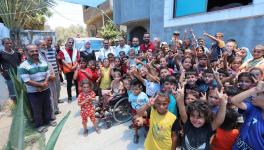East Africa Faces Worst Hunger Crisis in Decades
The wind is dry and the heat is punishing in Kapetadie, a remote village in Turkana County in northern Kenya near the border with South Sudan.
Parched earth stretches as far as the eye can see, littered with the carcasses of dead cows, goats and other livestock who have died of thirst and hunger.
"Our animals have died. Goats, cows, camels and donkeys," ward administrator Elijah Musekidor laments.
The village's only water source is not clean, he says. People, along with their animals, who also drink here, run the risk of getting sick and dying.
Only 10% of expected rainfall fell in Turkana in the last six months of 2021.
The vegetation is withered and there's little for the traditional herders living here to graze their animals on.
The surface water is also almost gone — 80% of water sources in Turkana have dried up, according to the United Nations humanitarian agency OCHA.
With livestock malnourished and dying, many here have no animals to sell at the market. And with harvests way below normal levels elsewhere in Kenya because of the lack of rain, food prices are skyrocking.
Kenya's Turkana County is one of the hardest hit regions
As a result, around two-thirds of Turkana's 900,000 people are facing starvation, Kenya's drought authority says.
The normally arid region has become even dryer as it experiences a years-long drought, says the head of Turkana's water service, Vincent Palor.
"We have not had rain for the last few years, and this is actually exacerbating the situation," he told DW.
To make matters worse, 40% of the county's boreholes that tap into groundwater reservoirs are not functional, a recent survey revealed, due to failure to provide routine maintenance.
Millions at risk of severe hunger
Many communities across East Africa are facing similar fates, with small-scale farmers and herders the hardest hit — and least able to cope.
The United Nations estimates that 13 million people across Kenya, Ethiopia, Eritrea and Somalia are suffering severe hunger due to persistent drought, as the region is hit with the driest conditions recorded since 1981.
Aid organizations worry that the situation in East Africa will likely deteriorate further without urgent and scaled-up support.
International aid group Oxfam warned that the hunger crisis could quickly turn into a "catastrophe" if aid fails to reach the most vulnerable.
"The brutal truth is that at the moment, East Africa is not on the global agenda,'' Oxfam International Executive Director Gabriela Bucher told the AP news agency.
Hundreds of thousands of people in East Africa could die this year due to the hunger crisis, she said.
Hunger forcing Somalis to flee
In Somalia, the drought emergency has intensified, with the number of people affected increasing to about 4.5 million people, up from 3.2 million in December 2021.
Many families in drought-ravaged rural areas are fleeing to major cities in search of food and water.
At the Al-Hidaya camp for internally displaced persons on the outskirts of the capital Mogadishu, Halimo Ali tries to console her four-year-old son.
Her family traveled to the camp, which currently holds more than 800 families, from the south of Somalia.
"We have lost our cows and goats because of the severe drought," Ali told DW. "We could not get food and water, so we decided to move."
Halimo Ali says she had to flee the devastating drought in southern Somalia
Malnourished children
Many of those arriving at the camp are malnourished and sick.
"These drought-affected people suffer from a lack of enough food while the children also suffer from anemia, measles, and weak bones," community leader and camp chairman Nadifo Hussein said.
He said that with more people traveling to the capital from drought-hit regions, the camp would soon be unable to help new arrivals.
"We need lifesaving intervention," he told DW.
Aden Farah, Humanitarian Advisor for Save the Children in Somalia, said about 671,000 people had been displaced internally in the country due to the drought.
In Somalia's 2011 famine, an estimated 250,000 people died, half of them children.
This time around, some 5 million Somalis already face acute food insecurity.
Drought-stricken Somali families are fleeing to the Al-Hidaya camp for internally displaced persons
Thelma Mwadzaya in Kenya and Mohamed Odowa in Somalia contributed to this article.
Edited by: Kate Hairsine
Get the latest reports & analysis with people's perspective on Protests, movements & deep analytical videos, discussions of the current affairs in your Telegram app. Subscribe to NewsClick's Telegram channel & get Real-Time updates on stories, as they get published on our website.



























